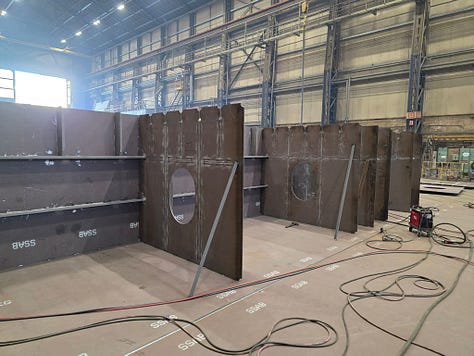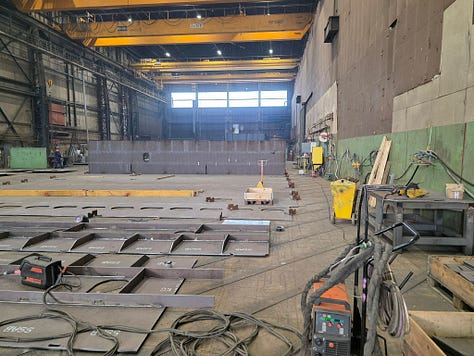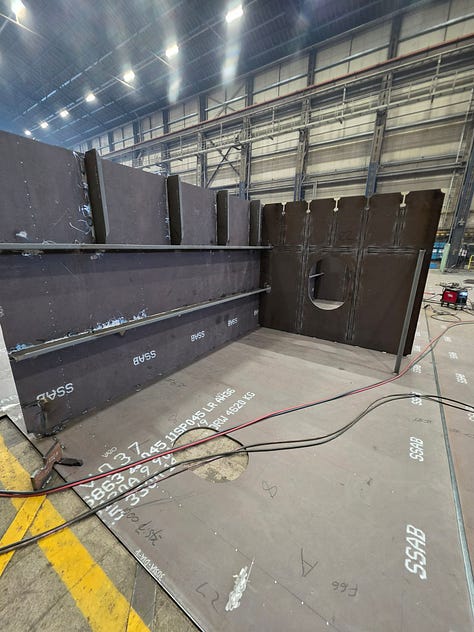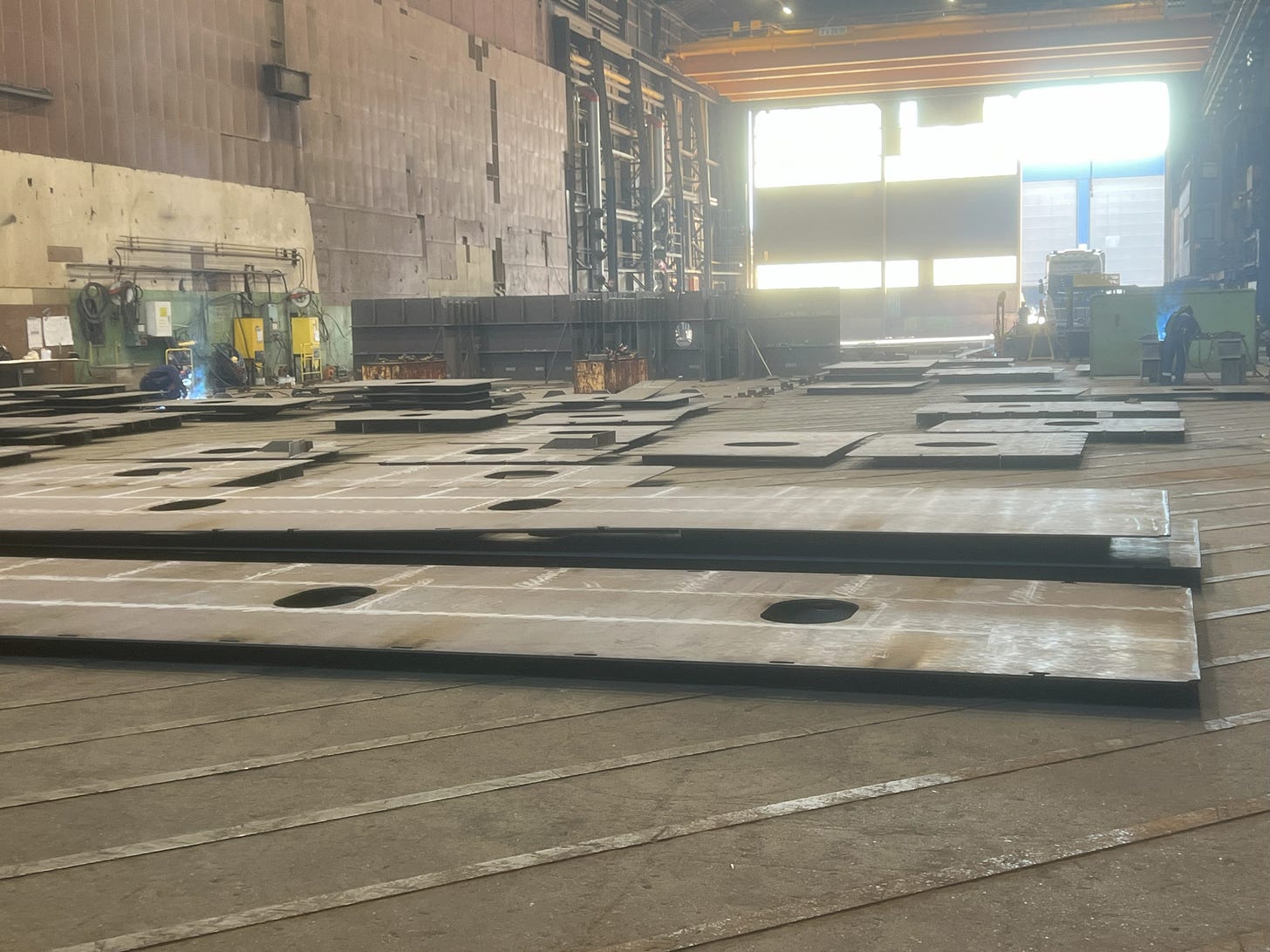Building a "Heavy" Icebreaker in Helsinki
I'll be tracking the progress of the Polar Class 2 Canadian Polar Icebreaker closely.

Despite my best efforts over the past several years1, I still hear people incorrectly state that Finland does not build heavy icebreakers2, or that they cannot build the types of icebreakers that the U.S. Coast Guard needs.
Finland doesn’t operate any truly polar icebreakers simply because they are not needed3. Rather, Finland uses its icebreaker fleet to keep its ports open throughout the winter. As a nation of just 5.5 million people, it would be difficult to justify spending limited taxpayer dollars to include unnecessary capabilities in its own vessels.
But Finnish companies have certainly designed and built such icebreakers for other customers. And now, we can see construction of a ‘heavy’ polar icebreaker in real time. As I reported earlier this year, Canadian shipbuilder Davie is building a Polar Class 2 heavy polar icebreaker for the Canadian Coast Guard. Part of the vessel will be built at Davie’s Helsinki Shipyard, and part in Quebec.
Production work began in Finland on August 20th, when Davie revealed this countdown until delivery (August 21, 2030). Yes, they fully intend to deliver a heavy polar icebreaker within five years, if not earlier (Davie claims it would take only 36 months if built entirely in Finland).

To demonstrate this capability in real time, I intend to track and document the work at Helsinki Shipyard over the next several years.
Production Day 20
Here is a photo I took during my visit to Helsinki Shipyard on September 9, 2025—20 days after construction began4:
This block will become one of the machinery spaces for the Canadian Polar Icebreaker.
After the visit, Davie provided me with a short video and some additional photos of the ongoing work:









Note that Helsinki Shipyard is but one of at least three locations where production work is ongoing. As I reported in July, Davie bought a shipyard in Pori, Finland mainly for its steel production facility:
This facility, re-named Sata Shipbuilding, restores major block production capability to Helsinki Shipyard, which sold off its steel production facilities in Helsinki around twenty years ago. (Unlike many shipyards, Helsinki Shipyard occupies valuable real estate right in the heart of a city.) In the interim, Helsinki Shipyard relied on subcontractors in Poland and Lithuania for its block production. Now Sata Shipbuilding will fill this role.
Work will also be occurring in Quebec.
Here’s a link to a recently released highlight video from the August 20, 2025 Steel Cutting Ceremony:
0:00-4:20: Highlights from speeches by James Davies (CEO Davie Shipbuilding), Alex Vicefield (CEO Inocea Group), Matias Marttinen (Finland’s Minister of Employment), Christopher Skeete (Quebec Minister of Industry), Stephe Fuhr (Canada’s Secretary of State for Defence Procurement), and Mélanie Joly (Canada’s Minister of Industry).
4:20-7:35: ‘Pressing the button’ and video of work starting at Helsinki Shipyard, Sata Shipbuilding, and Davie Shipbuilding.
7:35-10:41: Performance of The Shipbuilder’s March (Laivantakentajan marssi) in the drydock at Helsinki Shipyard.
Thoughts and Comments
I intend to closely follow and document construction of the Polar Class 2 ‘heavy’ Polar Icebreaker at Helsinki Shipyard in my continuing effort to correct the false belief that Finnish companies cannot build the types of icebreakers needed by the U.S. Coast Guard.
Part of this too is to document that Helsinki Shipyard can actually build ships in the timelines that it claims (and has historically demonstrated). There is so much finger pointing and questioning going on right now as different shipyard vie for future icebreaking contracts. One of the best ways to sort out ground truth is to ignore what is being said and watch what is actually happening.
You will also see me reporting on Rauma Marine Construction’s (RMC) progress building the Finnish Navy Corvettes. I cannot report in the same detail, because Rauma is several hours away by car (whereas I can get to Helsinki Shipyard in just 20 minutes). From what I’ve seen, RMC is doing fine work. At the moment, they have three (of a planned four) Corvettes in simultaneous production.
Thanks to Davie/Helsinki Shipyard for continuing to give me the access to document their project.
Please let me know if you have any questions. If I can’t answer them myself, I’ll ask the folks at Helsinki Shipyard during my next visit.
Until next time-
All the Best,
PGR
One of my early articles provides the background information as to how I became involved in icebreakers.
Although I don’t like the term ‘heavy’ icebreaker, I will use it because it is widely used within the U.S. Government. I don’t like it because it can mean different things (the USA and Canada use the term differently, for example). When I use it, I mean an icebreaker of Polar Class 2 (or better) designed specifically for use in the polar regions.
Finland does have three icebreakers with some polar capability. These were built in the 1990s with the intention of finding customers during the normally idle summer months. Although two of these vessels- Fennica and Nordica- have supported Arctic oil exploration in the past, there is currently no commercial market as Shell ended its Alaskan exploration in 2015. These multi-purpose icebreakers are more expensive to build and operate. As of today, Finland has no plans to build additional multi-purpose icebreakers.
September 9th is 185 days after the Canadian Coast Guard awarded Davie the build contract, and about a year after Davie was awarded a contract ($16.47 million Canadian) for advance work on a Polar-class icebreaker. Davie funded the design work itself; there is no separate design contract.




Thanks for covering this project in deep detail Peter. As a very interested Canadian I look forward to every future installment of this multi-year build. You have a lot of reporting ahead!
I thought delivery was 26 months not 36?